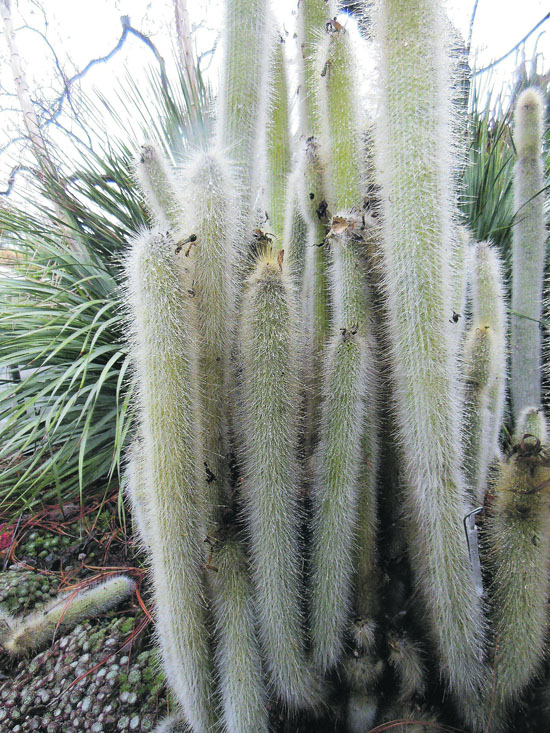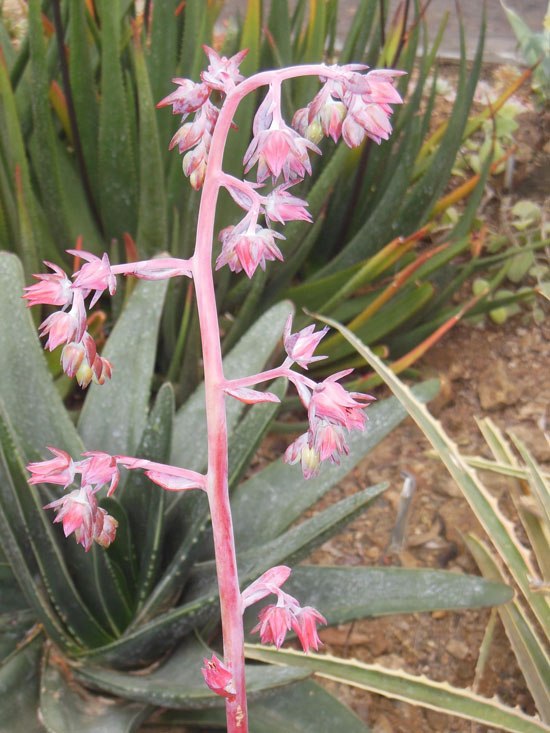|
|
Published April 9th, 2014
|
Digging Deep-Gardening with Cynthia Brian
|
| Don't Doubt the Drought |
| By Cynthia-Brian |
 |
| Pretty, prickly, and great in drought plantings. Just don't fall in it! Cleistocactus hyalacanthus (white-spined columnar cactus) Photos Cynthia Brian |
Hurray for the rain! How happy we have been to utilize our umbrellas for the recent April showers. But don't confuse this limited precipitation with full reservoirs. The recent downpours were only a trickle. The snowpack remains at only 30 percent of necessary and the water level in our lakes hovers around 50 percent of normal. Don't doubt this drought. It is here to stay and we have to adjust to the coming season of dry weather. Conservation is critical.
 Do you know what xeriscaping is? Although some people have nicknamed the system "zero-scaping," nothing could be further from the truth. Xeriscaping is a beneficial way to conserve water while maintaining a beautiful garden. Gardens may contain cacti and succulents, but many other drought tolerant specimens are also included. Plants with similar water requirements are grouped together and the use of the plot is considered. Areas for relaxing, eating, playing, sitting, and privacy are part of the plan. Trees and shrubs are positioned to provide heating and cooling while curved wide swaths are encouraged for easier water efficiency. The resulting benefit of xeriscaping is a low maintenance garden that is drought resistant, water conserving, and a habitat for wildlife. Water usage may be reduced by as much as 50-75 percent.
Do you know what xeriscaping is? Although some people have nicknamed the system "zero-scaping," nothing could be further from the truth. Xeriscaping is a beneficial way to conserve water while maintaining a beautiful garden. Gardens may contain cacti and succulents, but many other drought tolerant specimens are also included. Plants with similar water requirements are grouped together and the use of the plot is considered. Areas for relaxing, eating, playing, sitting, and privacy are part of the plan. Trees and shrubs are positioned to provide heating and cooling while curved wide swaths are encouraged for easier water efficiency. The resulting benefit of xeriscaping is a low maintenance garden that is drought resistant, water conserving, and a habitat for wildlife. Water usage may be reduced by as much as 50-75 percent.
 There is no right or wrong in the garden, but this year, we definitely must be water conscious.
There is no right or wrong in the garden, but this year, we definitely must be water conscious.

 Drought Gardening Series - Part 2
Drought Gardening Series - Part 2
 Next Steps
Next Steps

 PLANT WISELY
PLANT WISELY
 Maintenance, not growth, is the goal of gardeners during a drought. If you must plant, decide on drought-tolerant plants instead of thirsty ones. In general, plants that can survive the dry times have leaves that are thick, small, glossy, fuzzy, or silver-grey. Be aware of exposure. Don't mix flowerbeds with plants that have different needs. Hot, dry areas with south or west exposures require more water while east and north facing gardens retain their moisture longer. Natives and desert plants drink less. Plant now while the weather is cooler and refrain from planting during the warmer months. Consider vegetables that will give you the biggest bang for your water buck such as tomatoes, beans, artichokes, eggplant, peppers, squash, Swiss Chard, lettuces, and cucumbers while eliminating choices that produce just one crop like cauliflower.
Maintenance, not growth, is the goal of gardeners during a drought. If you must plant, decide on drought-tolerant plants instead of thirsty ones. In general, plants that can survive the dry times have leaves that are thick, small, glossy, fuzzy, or silver-grey. Be aware of exposure. Don't mix flowerbeds with plants that have different needs. Hot, dry areas with south or west exposures require more water while east and north facing gardens retain their moisture longer. Natives and desert plants drink less. Plant now while the weather is cooler and refrain from planting during the warmer months. Consider vegetables that will give you the biggest bang for your water buck such as tomatoes, beans, artichokes, eggplant, peppers, squash, Swiss Chard, lettuces, and cucumbers while eliminating choices that produce just one crop like cauliflower.

 PLANT CLOSE TOGETHER
PLANT CLOSE TOGETHER
 Learn from the Native Americans who planted "Three Sisters" including corn, beans, and squash. According to Iroquois legend, corn, beans, and squash are three inseparable sisters who grow and thrive together. The beans provide nitrogen, the corn is a trellis where beans can grow, and the prickly foliage of the squash keep the corn worms away in a sustainable system that has been used throughout history. Instead of organizing your garden in rows, plant in close knit squares or swathes to pack the punch in small places. Use tall plants as canopies of shade. In the fall, add a cover crop mix to protect and fertilize garden beds after harvest.
Learn from the Native Americans who planted "Three Sisters" including corn, beans, and squash. According to Iroquois legend, corn, beans, and squash are three inseparable sisters who grow and thrive together. The beans provide nitrogen, the corn is a trellis where beans can grow, and the prickly foliage of the squash keep the corn worms away in a sustainable system that has been used throughout history. Instead of organizing your garden in rows, plant in close knit squares or swathes to pack the punch in small places. Use tall plants as canopies of shade. In the fall, add a cover crop mix to protect and fertilize garden beds after harvest.

 DEADHEAD REGULARLY
DEADHEAD REGULARLY
 Don't allow seeds or pods to form as they zap energy and use more water to form the seeds. By deadheading, you'll keep the juices flowing. Do not prune heavily as water-deprived plants are stressed and may not have the capacity to heal the pruned branches resulting in death. Pruning encourages side shoots and stimulates growth, which is not what you are seeking in a drought. Deadheading just the spent flowers is the key to keeping your plants alive.
Don't allow seeds or pods to form as they zap energy and use more water to form the seeds. By deadheading, you'll keep the juices flowing. Do not prune heavily as water-deprived plants are stressed and may not have the capacity to heal the pruned branches resulting in death. Pruning encourages side shoots and stimulates growth, which is not what you are seeking in a drought. Deadheading just the spent flowers is the key to keeping your plants alive.
 TURF WARS
TURF WARS
 Lawns are warriors. They can absorb a mountain of abuse as they give our eyes a rest from concrete chaos. I love a lawn for the visual appeal as well as the functionality of recreational activities and am not about to abandon my green space in order to be politically correct. Although lawns may not be as green as the Emerald Isle with minimal irrigation, they will survive when you take these steps:
Lawns are warriors. They can absorb a mountain of abuse as they give our eyes a rest from concrete chaos. I love a lawn for the visual appeal as well as the functionality of recreational activities and am not about to abandon my green space in order to be politically correct. Although lawns may not be as green as the Emerald Isle with minimal irrigation, they will survive when you take these steps:
 1. Allow the grass clippings to remain on the grass to recycle nutrients and moisture.
1. Allow the grass clippings to remain on the grass to recycle nutrients and moisture.
 2. Reseed or repair lawns with drought resistant fine fescues.
2. Reseed or repair lawns with drought resistant fine fescues.
 3. Set your mower height to three inches to encourage deeper roots.
3. Set your mower height to three inches to encourage deeper roots.
 Allow grass to go dormant when water is not available. Unless conditions are extreme, your lawns will return when the seasons grow cooler.
Allow grass to go dormant when water is not available. Unless conditions are extreme, your lawns will return when the seasons grow cooler.

 SAVING WATER
SAVING WATER
 Gray water is good for your garden. Keep a bucket in your shower and near your bath. Rinse and wash dishes in a container to recycle the soapy suds. If possible re-route your washing machine hose to water your landscape. Use wine barrels to catch rainwater and divert downspouts to your flowerbeds. Don't use roof run-off on your edibles.
Gray water is good for your garden. Keep a bucket in your shower and near your bath. Rinse and wash dishes in a container to recycle the soapy suds. If possible re-route your washing machine hose to water your landscape. Use wine barrels to catch rainwater and divert downspouts to your flowerbeds. Don't use roof run-off on your edibles.

 CREATE SHADE
CREATE SHADE
 Use market umbrellas, canvas tarps, or canopies to create false shade. Move containers to covered patios or overhangs to reduce the direct sunlight from already stressed plants.
Use market umbrellas, canvas tarps, or canopies to create false shade. Move containers to covered patios or overhangs to reduce the direct sunlight from already stressed plants.

 BUILD WINDBREAKS
BUILD WINDBREAKS
 Wind dries the soil. Natural windbreaks include trees, shrubs, grasses, and hedges. Use decorative screens, art, or furniture as man-made wind barriers.
Wind dries the soil. Natural windbreaks include trees, shrubs, grasses, and hedges. Use decorative screens, art, or furniture as man-made wind barriers.

 RAISED BEDS
RAISED BEDS
 A magnificent solution to numerous gardening challenges is to buy or build raised beds. Self-contained cow troughs are excellent since no critters can get in for a nibble and they retain water. Whether your raised beds are made of wood, concrete, aluminum, or other material, make sure that the bottom is protected with wire and that you add a few inches of gravel to the bottom for drainage. Fill with good soil, compost, mulch, and crowd your plantings together. Raised beds save backs and knees as they eliminate the bending necessary for most garden tasks.
A magnificent solution to numerous gardening challenges is to buy or build raised beds. Self-contained cow troughs are excellent since no critters can get in for a nibble and they retain water. Whether your raised beds are made of wood, concrete, aluminum, or other material, make sure that the bottom is protected with wire and that you add a few inches of gravel to the bottom for drainage. Fill with good soil, compost, mulch, and crowd your plantings together. Raised beds save backs and knees as they eliminate the bending necessary for most garden tasks.

 DRY FARMING
DRY FARMING
 I grew up on a dry farm. The flavors from the harvest were always intense, robust, and delicious. To dry farm, build your soil first with extra amounts of compost and use cover crops such as alfalfa, oats, beans, or vetch. When you plant your vegetables and fruit teach them to survive without water by giving them only a few drops to keep them alive. Once the fruit is set, stop watering completely.
I grew up on a dry farm. The flavors from the harvest were always intense, robust, and delicious. To dry farm, build your soil first with extra amounts of compost and use cover crops such as alfalfa, oats, beans, or vetch. When you plant your vegetables and fruit teach them to survive without water by giving them only a few drops to keep them alive. Once the fruit is set, stop watering completely.

 By using all of the tips of the past two issues of Digging Deep-Gardening with Cynthia Brian, you will have begun your journey to xeriscaping.
By using all of the tips of the past two issues of Digging Deep-Gardening with Cynthia Brian, you will have begun your journey to xeriscaping.

 My Drought Gardening series continues next month when Part Three features a list of drought tolerant plants. Stay tuned!
My Drought Gardening series continues next month when Part Three features a list of drought tolerant plants. Stay tuned!




|
Cynthia Brian's Mid-Month Reminders

 � ADD a birdbath to your xeriscaping as it is essential to provide water for our feathered friends. � ADD a birdbath to your xeriscaping as it is essential to provide water for our feathered friends.
 � SAVE the bulbs from the Easter gifts of lilies and tulips. Plant in the ground for a more spectacular repeat bloom next year. � SAVE the bulbs from the Easter gifts of lilies and tulips. Plant in the ground for a more spectacular repeat bloom next year.
 � MIX and match blue bachelor buttons, with white scabiosa, and pink dianthus for an easy, enchanted display. � MIX and match blue bachelor buttons, with white scabiosa, and pink dianthus for an easy, enchanted display.
 � CONTROL pests with healthy gardening practices that are eco-friendly. � CONTROL pests with healthy gardening practices that are eco-friendly.
 � SAVE space and water by planting a disease resistant fruit salad tree that has been grafted with multiple varieties of your favorites. � SAVE space and water by planting a disease resistant fruit salad tree that has been grafted with multiple varieties of your favorites.
 � CELEBRATE the Earth Day Wildlife Festival from 1 to 4 p.m. April 27 at the Wagner Ranch Nature Area in Orinda. � CELEBRATE the Earth Day Wildlife Festival from 1 to 4 p.m. April 27 at the Wagner Ranch Nature Area in Orinda.
 � BUY heirloom and organically grown plants from Moraga Community Garden sale every weekend in April located behind the � BUY heirloom and organically grown plants from Moraga Community Garden sale every weekend in April located behind the
 walnut barn off of Moraga Way. walnut barn off of Moraga Way.

 May flowers depend on more April showers thus we'll continue our rain dances. Wishing you a very Happy Easter and Passover. May flowers depend on more April showers thus we'll continue our rain dances. Wishing you a very Happy Easter and Passover.
 Happy Gardening! Happy Growing! Happy Gardening! Happy Growing!


 (c)2014, Cynthia Brian (c)2014, Cynthia Brian
 The Goddess Gardener The Goddess Gardener
 Cynthia@GoddessGardener.com Cynthia@GoddessGardener.com
 http://www.GoddessGardener.com http://www.GoddessGardener.com
 925-377-7827 925-377-7827
 Cynthia is available as a speaker and consultant. Cynthia is available as a speaker and consultant. |
 |
| Tulips are the ultimate spring surprise. |
 |
| Echeveria are excellent choices for xeriscaping. |
 |
| Cynthia Brian |
|
|
 |
|
|
|
|










